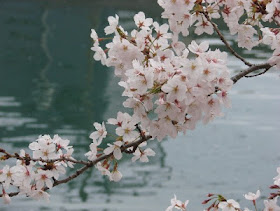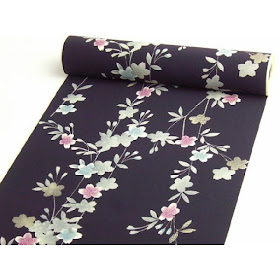Here is the next installment in my big seasonality translating project: to get aligned with the calendar month, I've dropped back to March and will go in chronological order from here on out. Did you know that apparently March can be considered beach-opening season?
(If you're looking to buy kimono, I recommend
Rakuten
for new ones, especially casual wear, and
Ichiroya for nice vintage ones!)
The Month of March
Kimono
 |
| Donsu, a type of contrasting satin weave |
Kimono are lined. Choose rinzu, chirimen, and donsu (silk/satin damask) silks or tsumugi (pongee silk) with spring-related patterns. In the case of chirimen silk, use things like hitokoshi or kawari-chirimen. For rinzu silks or “mon-ishou” (pattern design) silks, woven designs of spring-related things like flowing water, mist, waves, and flowers bring a feeling of freshness. For colors, light
colors hazy with white or grey suggest spring. It’s good to use slightly muted
colors like brown-red (azuki) 98514B, gray (nezumi) 8A8C8E, pale pink (sakura)
FEEEED, or rape-blossom yellow (na-no-hana) FFEC50, young-grass green (waka-kusa)
C3D941, and light blue (mizu-iro) AFDFE4.
 |
| Mon-ishou silks |
Patterns reminiscent
of spring dyed on a gradated background are suitable, as are plain-color kimono
with family crest(s).
Obi
In situations where a
fukuro obi is called for, choose something with a small pattern like what you
see on some “fukusa” (tea cloth wrappers).
Accessories
Obi-age are gradated
rinzu silk or shibori, and obi-jime are somewhat narrow like the “kanze-hineri” or “yurugi” (crown-style) types.
 |
| Kanze-hineri type |
 |
| Yurugi type |
Naga-juban are unlined
on the body part only, and are plain or gradated. Han-eri are white
shioze, habutae, or chirimen silk. For footwear, choose
zori with slightly high heels in bright colors that coordinate with the kimono.
Notes (original author's)
In the first part of
the month, lined coats are used with unlined coats coming into use in the
middle of the month. By the end of the month we see unlined or “sha” (gauze
silk) lined ones. Create a feeling of elegance by using a coat that coordinates
well with the color of your kimono.
Colors
Colors like fresh
green (waka-midori) 9DD29C, silver-gray (gin-nezu) A1A3A6, finch green (hiwa-iro)
CBC547, water light blue (mizu-asagi) 80ABA9, cream FFEDB3, light orange
(awai-orenji) F8A885, and neutral warm colors with white in them.
Patterns
Hina Matsuri (Doll
Festival/Girls’ Day) dolls (hina-ningyou), shell-matching game (kai-awase),
formal fans (ougi), flowing water/streams (ryuu-sui), spring gradated colors,
mist (kasumi), and from the middle of the month cherry blossom patterns
(sakura) are used.
 |
| Hina Matsuri dolls |
 |
| Shell-matching game |
 |
| Formal fans |
 |
| Flowing water/streams |
 |
| Spring gradated colors |
 |
| Mist |
 |
| Cherry blossoms |
March Flowers
Cherry blossom
(sakura), cherry blossom branches (eda-sakura), weeping cherry
(shidare-zakura), falling/scattering cherry blossoms (chiri-sakura), dandelion
(tampopo), violets (sumire), fields of spring
flowers, peaches (momo), kobus magnolia (kobushi), weeping golden bell
(ren-gyou), primula like primrose, cowslips, etc. (sakura-sou).
See above for general cherry blossoms.
 |
| Cherry blossom branches |
 |
| Weeping cherry |
 |
| Falling/scattering cherry blossoms |
 |
| Dandelions |
 |
| Violets |
Fields of general spring flowers.
 |
| Peach blossoms |
 |
| Kobus magnolia |
 |
| Weeping golden bell |
 |
| Primula (like primrose, cowslips, etc.) |
Patterns Associated with March
Due to the opening of
beach-going season: assorted shells (kai-zukushi), shell baskets (kai-oke), and
shells of the shell-matching game (kai-awase).
Due to the Doll Festival/Girls’ Day: flutes (fue), taiko drums.
 |
| Assorted shells |
 |
| Shell baskets |
See first section for shell-matching game.
 |
| Flutes |
 |
| Taiko drums |
More (Original Author) Notes
Assorted spring lined
kimono: March 3 is the Doll Festival/Girls’ Day. This festival is counted as
one of the classical
Five Festivals (January 7, March 3, May 5, July 7,
September 9). It’s a girlish and splendid festival with the
traditional doll decorations, peach blossoms, and rape blossoms (the name comes
from an old English word for turnip, rapum).
 |
| A furidashi container |
Tea ceremonies held
around the Doll Festival should offer konpeitou (a special colored sugar candy)
or arara (roasted mochi pieces) in a special cylinder kind of sweets container
called a “furi-dashi”. Like shaking the furi-dashi to reveal colorful pieces of
candy as they fall out, we can enjoy a colorful Girls’ Day atmosphere by using brightly
colored kimono with fine patterns (komon) while sitting near the kettle hanging
over the tea room’s hearth.
The anniversary of (hugely
influential tea ceremony master) Sen no Rikyuu’s death is also in March (March
28 as observed by the popular Urasenke School). If you go out on this day, an
iromuji with crests and a mature, quiet obi are suitable.
Generally, the woven
background pattern of an iromuji (formal single-color kimono) can include things like mist or clouds, stylized
ocean waves (sei-gai-ha), the flowing of water (mizu-no-nagare), patterns taken
from famous things, arabesque designs (karakusa), or other suitably formal
patterns. If using a floral background pattern, it should feature stylized
flowers in repeating circles (kamon).
 |
| Stylized ocean waves |
 |
| Arabesque design |
Kimono colors should
be chosen from composed ones that reflect the colors of spring flowers. Obi
with a black background are not used this month (too reminiscent of all-black
mourning obi). Nagoya obi in background colors like silver gray (gin-nezu)
A1A3A6, maroon (ebi-cha) 7C4036, seaweed green (miru no midori) 6E6B41, light
tea (shibu-iro) E6BE91, ash gray (hai-iro) 717375 with hand-drawn and dyed
seasonal flowers or the lotus flower (hasu) match the season well.
Woven (tsuzure) Nagoya obi with small patterns like “mei-butsu-gire” or old court patterns (koten) are good to use. With obijime and obiage, loud and flashy colors should be avoided: like the kimono colors this month, plain and subdued colors that won’t stand out too much are used.
 |
| Mei-butsu-gire |
 |
| Old court patterns, here mixed with mist |
Translator Footnotes
No special footnotes this time around.
Translator Notes
Nothing in particular for this month.
(Notes below repeated from previous months)
-The original author repeats several points, so with certain common terms I am using the Japanese name on first mention only. If you’re unsure of something, feel free to ask and I can clarify.
-The number next to the color name is that color's hex code as used in HTML. Keep in mind the exact shade may vary as well, from what I've seen cross-checking traditional color-name sites with actual kimono vendors.
- As a note, this is
a translation of a tea ceremony kimono site. The tea ceremony world, I have learned, is among the strictest when it comes to following proper seasonality rules, so bear in mind that these rules are more stringent than the general thinking for daily and casual kimono wearers.
It’s great if a daily wearer can put together an outfit following all of these rules, but very few will look at you funny if you can’t, as it’s hard and can be expensive to collect all the proper pieces. I’m translating this site more as part of my efforts to add to the world of English-language kimono information for those who don’t speak Japanese.
 for new ones, especially casual wear, and Ichiroya for nice vintage ones!)
for new ones, especially casual wear, and Ichiroya for nice vintage ones!)






















































Thank you for translating and interpreting these texts! It's a wonderful resource!
ReplyDeleteYou're welcome. :) I'm glad you're finding them helpful!
ReplyDeleteOh, March became my favourite month so far, when it comes to traditional patterns... The kai-awase, fans, hinamatsuri dolls and all the lovely flowers (specially sakura) look so beautiful!
ReplyDeleteThanks again for your hard work with these wonderful posts! ^^
By the way, could I post a link for your blog on my blog? Kimono is one of the subjects I talk a lot about there, and I think my followers would love to know The Kimono Lady! ^^
Christina-
ReplyDeleteI cannot thank you enough for your hard work! I have been researching japanese fabrics, and your translation work is not only awe-inspiring, it has been crucial in my understanding the motifs and fabric structure I'm working with! There is simply so much out there, this tea-ceremony site is obviously a great place for information, thank you again and again for making it available to the English-speaking community!
Thank you very much, Mai-chan and A.B.!
ReplyDeleteMai-chan: Sure, no problem. Thank you very much for asking! :) (And yes, I adore these spring motifs, especially kai-awase. <3)
A.B.: Let me know if you have a specific question at any point about a particular fabric and I'll be happy to help if I can. I usually go semi-cross eyed learning about them in the course of my translations as it can get pretty esoteric.
This is a very useful information! I've been trying to adopt recently the Japanese traditional style of wearing Japanese kimono colors and patterns that suit each month and the season. Guess it makes modern-day dressing more interesting. Can't thank you enough for your generosity in sharing this knowledge to all of us.=)
ReplyDelete